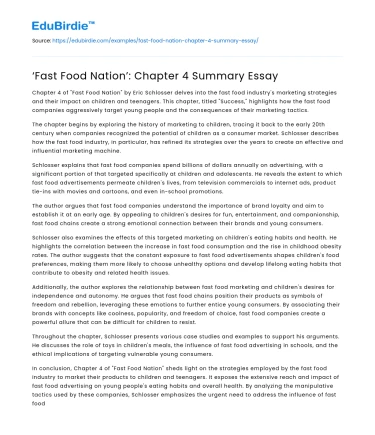Chapter 4 of "Fast Food Nation" by Eric Schlosser delves into the fast food industry's marketing strategies and their impact on children and teenagers. This chapter, titled "Success," highlights how the fast food companies aggressively target young people and the consequences of their marketing tactics.
The chapter begins by exploring the history of marketing to children, tracing it back to the early 20th century when companies recognized the potential of children as a consumer market. Schlosser describes how the fast food industry, in particular, has refined its strategies over the years to create an effective and influential marketing machine.
Save your time!
We can take care of your essay
- Proper editing and formatting
- Free revision, title page, and bibliography
- Flexible prices and money-back guarantee
Schlosser explains that fast food companies spend billions of dollars annually on advertising, with a significant portion of that targeted specifically at children and adolescents. He reveals the extent to which fast food advertisements permeate children's lives, from television commercials to internet ads, product tie-ins with movies and cartoons, and even in-school promotions.
The author argues that fast food companies understand the importance of brand loyalty and aim to establish it at an early age. By appealing to children's desires for fun, entertainment, and companionship, fast food chains create a strong emotional connection between their brands and young consumers.
Schlosser also examines the effects of this targeted marketing on children's eating habits and health. He highlights the correlation between the increase in fast food consumption and the rise in childhood obesity rates. The author suggests that the constant exposure to fast food advertisements shapes children's food preferences, making them more likely to choose unhealthy options and develop lifelong eating habits that contribute to obesity and related health issues.
Additionally, the author explores the relationship between fast food marketing and children's desires for independence and autonomy. He argues that fast food chains position their products as symbols of freedom and rebellion, leveraging these emotions to further entice young consumers. By associating their brands with concepts like coolness, popularity, and freedom of choice, fast food companies create a powerful allure that can be difficult for children to resist.
Throughout the chapter, Schlosser presents various case studies and examples to support his arguments. He discusses the role of toys in children's meals, the influence of fast food advertising in schools, and the ethical implications of targeting vulnerable young consumers.
In conclusion, Chapter 4 of "Fast Food Nation" sheds light on the strategies employed by the fast food industry to market their products to children and teenagers. It exposes the extensive reach and impact of fast food advertising on young people's eating habits and overall health. By analyzing the manipulative tactics used by these companies, Schlosser emphasizes the urgent need to address the influence of fast food marketing on children and protect their well-being.






 Stuck on your essay?
Stuck on your essay?

